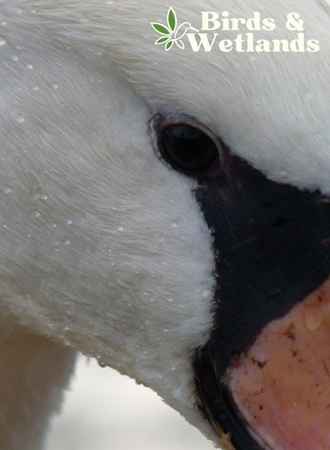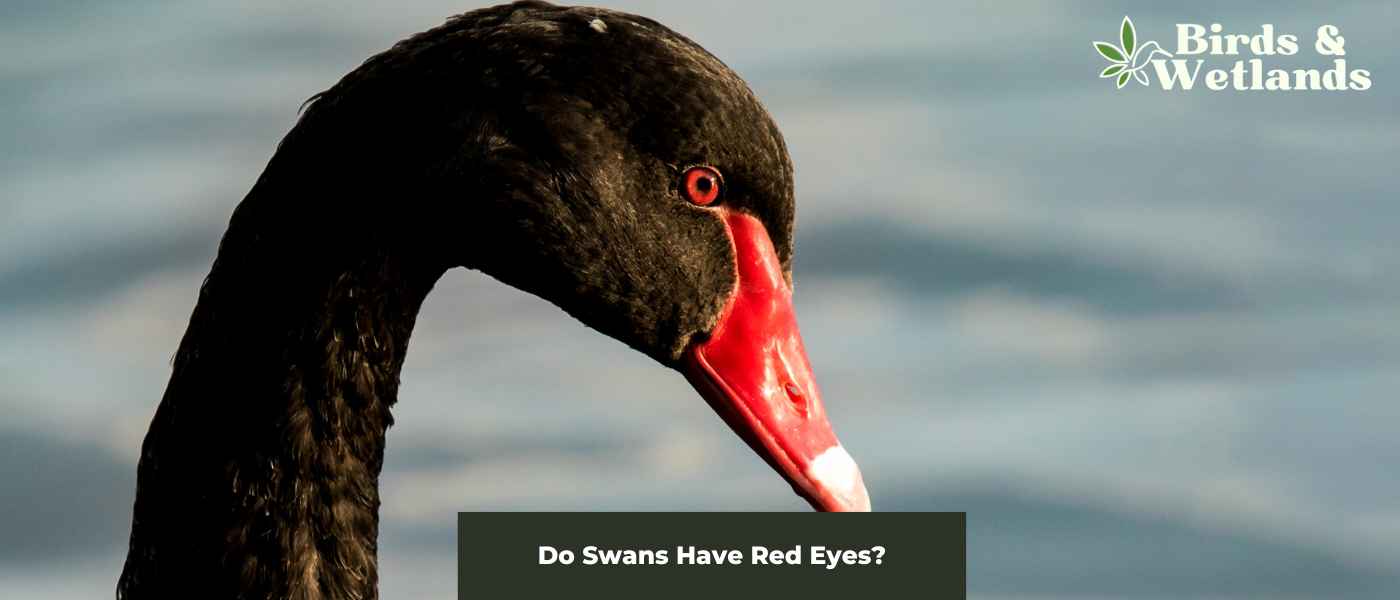Swans are considered some of the most graceful birds in the animal kingdom. Their long necks and elegant movements make them a popular subject in art and literature. Known for their grace and beauty, swans are often associated with love, purity, and nobility.
While most species of swans have black or brown eyes, one exception is the Australian black swan. Unlike other swan species, the black swan has red eyes that turn white during the non-breeding season. This unique feature is most prominent during the breeding season when the red color becomes more intense, making them stand out among other swans.
Key Takeaways on Black and White Swans’ Eyes
- The white swan has dark eyes while the black swan has white eyes that turn red during the breeding season.
- Swans have excellent vision which is important for their survival.
- Swans can engage in unihemispheric slow-wave sleep.
What color are swan eyes?
The whooper swan, tundra swan, mute swan, trumpeter swan and black-necked swan all have black or dark grey eyes. The eyes of the black swan (Cygnus atratus) are white but turns red during the breeding season.

Do swans have good eyes?
Swans are known for their striking beauty and grace, but their visual capabilities are often overlooked. These waterfowl possess highly developed eyesight, allowing them to navigate their environments precisely and efficiently.
The structure of a swan’s eye is similar to that of other birds, with a large cornea, a small pupil, and a dense array of photoreceptors. The eye size relative to the skull is also larger in swans than in most other birds. This large size allows for a greater field of vision and increased sensitivity to light, enabling swans to see in both low-light and bright conditions.
In addition to their large eyes, swans also have specialized cells in their retinas called double cones, which are responsible for color vision. These cells allow swans to see a wide range of colors, including ultraviolet light, which is invisible to humans. This ability is particularly useful for swans during mating season, as they use brightly colored plumage to attract potential partners.
Swans also have an excellent spatial resolution, which allows them to see small objects in great detail. This is particularly useful for detecting predators and finding food, as swans are opportunistic feeders that consume various aquatic plants and animals.

Do swans remember humans?
Swans are beautiful and intelligent animals – it’s no wonder why so many people are fascinated with them. Their depiction in stories, myths and legends has captivated imaginations for centuries.
One thing that captivates us the most is perhaps their ability to remember those that have interacted with them, for good or for bad. While it is still unknown how good a swan’s memory is, there is evidence to suggest that they can recognize friendly humans and those who weren’t over long periods – indicating that they possess some recollection.
Swans also react differently depending on the person they encounter – much as we would recognize an old acquaintance if we bumped into them on the street. This shows us that this majestic animal is capable of more than we initially thought!

Do swans sleep with one eye open?
Swans do not sleep with one eye open. Like many birds, swans can engage in unihemispheric slow-wave sleep, meaning they can sleep with one half of their brain while the other half remains alert. This ability allows them to be on the lookout for potential predators while they sleep.
However, this does not mean they are physically keeping one eye open while sleeping. They can close both eyes and rest their body and mind, but half of the brain remains active to monitor the environment for any danger.

FAQs on Swans
What do black swans eat?
Black swans are omnivorous birds with a red bill and long neck, which means they eat both plants and animals. In the wild, their diet primarily consists of aquatic plants, such as algae, and aquatic animals, such as insects, crustaceans, and mollusks. They also eat small fish and amphibians.
Black swans are known to forage for food in shallow waters and use their long necks to reach underwater plants. They also graze on land, eating grasses, seeds, and other vegetation types.
Additionally, black swans are known to eat human-made food, such as bread and other types of food, that are often found in areas where they live in close proximity to people. While this feeding habit isn’t necessarily good for the birds, it can give them much-needed energy when food is scarce.
What do you call a baby swan?
A baby swan is called a cygnet.

What do you call a male swan?
A male swan is called a cob.
Is a baby black swan born with black feathers?
No, young swans called cygnets are born with waterproof pale gray down feathers.
Are black swans of Western Australia migratory?
The Australian black swan (Cygnus atratus) is a migratory bird species native to Australia and parts of New Zealand. They are known for having black plumage with white feathers on the wings, greyish-black webbed feet and a bright red beak with a white band near the tip. They also have the longest neck of any swan.
Most black swans inhabit wetland habitats such as ponds and shallow lakes of western and eastern Australia, where they mostly feed on aquatic and marshland plants. Large groups of black swans breed in the southeast and southwest regions of the country. They occasionally venture onto deeper water, especially when they forage food along Australia’s coasts.
With erratic migration patterns dependent on various conditions, the black swans are known to travel great distances in search of food and breeding grounds, and their movements can significantly impact the ecosystems they inhabit.
Several factors, including the availability of food and water, the onset of the breeding season, and changes in weather patterns, influence the migratory patterns of the Australian black swan.
For example, during the dry seasons, black swans may travel long distances to find suitable wetlands or rivers where they can forage for food and breed. In contrast, during the wet seasons, they may stay in one area for an extended period.
Despite traveling long distances, black swans can navigate back to their breeding grounds with great accuracy. This ability is due to their ability to use a variety of cues, such as the earth’s magnetic field, the position of the sun and stars, and the landscape’s topography.
Human activities also influence the migratory patterns of the Australian black swan. For example, the construction of dams and other man-made barriers can disrupt the birds’ movements and limit their access to food and breeding grounds.
Additionally, the destruction of wetlands and habitat loss through land-use changes can negatively impact the birds’ populations.

Is the Coscoroba swan a swan?
Despite their name, Coscoroba swans of South America are not considered true swans hence they’re not part of genus Cygnus.

Are black swans protected in Australia?
The National Parks and Wildlife Act protects black swans in New South Wales.
Do black swans have black feathers?
Yes, black swans have black feathers with white flight feathers visible in flight.
Are male black swans slightly larger than the females?
The females are slightly smaller than the males, which are also called cobs. The males also have a straighter bill than the female.
What is the current conservation status of the black swan?
The black swan is not a threatened species and is currently listed as Least Concern by the IUCN. They have an estimated global population of 100,000 to 500,000 birds.
When do black swans reach sexual maturity?
Most black swans reach sexual maturity upon reaching the age of two years.
What are the breeding habits of the black swan?
The black swan is a large bird that built its nest near shallow water, hidden among dense aquatic vegetation. The female lays four to nine eggs and both parents share incubation duties until the final egg is hatched and raising downy cygnets (young signets), which is uncommon among waterfowl.


